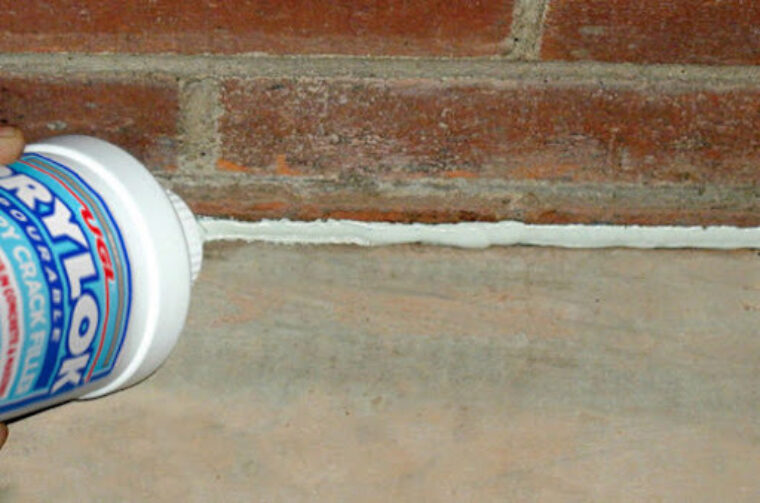Cracks are present in every concrete slab, and they are unavoidable due to the rigid nature of concrete. Uneven drying, shrinkage and temperature changes can all cause fractures in your slab. To avoid water seepage and further damage, it’s critical to seal any cracks that develop. This article will discuss why cracks happen and how to quickly repair them.
To put matters into perspective and make this process as simple as possible, we’ve written this step-by-step article to discuss the process.

Why is it Critical to Fill Cracks in Concrete?
Cracks in concrete may be a sign of deeper underlying problems, and if they’re not addressed quickly, they can lead to bigger issues and costly repairs. The first thing to do is determine the seriousness of the crack. Hairline cracks that are only seen from inside the home or on the surface of patios and sidewalks are generally safe and can be filled to prevent water from entering the area, causing further deterioration. Cracks larger than ¼” that can be seen from inside and outside the building should be inspected by a professional.


Structural Damage
Cracks in concrete can be the result of structural or non-structural issues. Structural problems could mean that your home is in danger of collapse , but the common cause of cracks in slabs, poured masonry walls or block walls is settling.
All buildings experience settling, and normal engineering practices will prevent this from causing structural damage. However, the issue may be more serious like a faulty foundation or poorly-mixed concrete.
As a general rule, if the crack in a vertical wall is longitudinally running, then this could be the sign of a weakened wall — especially if the wall is bowing inside. In block or brick walls, this problem usually develops with a visible stair-step pattern. If the cracks are seen outside and inside the structure, you should have a professional inspector determine if the problem is serious. Cracks that are ⅛” or smaller in width and less than ¼” deep can be filled with a product like DRYLOK® Masonry Crack Filler or DRYLOK® Pourable Masonry Crack Filler to seal the area.
Chemical Damage
There are numerous chemical reactions that can damage concrete. Here are a few that are important to note:
Carbonation
This occurs when concrete is exposed to carbon dioxide in the air. Calcium hydroxide is a component of concrete that can react with carbon dioxide to form calcium carbonate, which can lower the material’s strength and also its pH, making it more prone to corrosion.
Sulfate Attack
Most soil types include sulfates in the form of calcium, magnesium, sodium, ammonium and potassium and may be found in either soil or groundwater. These types of soils could harm concrete when a building is erected on top of them.
Alkali-Silica Reaction
The resultant chemical reaction between alkalis in cement and the silica content of aggregates produces a gel-like substance that absorbs water and increases the volume of concrete. Concrete fractures and decays are a consequence of this growing volume.
Corrosion of Metal Reinforcement
Corrosion occurs when the chloride ions contact the steel and surrounding passive material, resulting in a chemical process that creates hydrochloric acid. The hydrochloric acid eats away at the steel reinforcement, causing concrete cracking, spalling and failure.
How to Fill Cracks
When you want to repair the common cracks found in sidewalks and other concrete structures, there are some simple procedures to follow. The most important factor when filling a crack is to use a flexible sealant that will stretch as the concrete moves, ensuring that the repair stays in place. The following procedure is recommended for cracks that are ½” wide or less and ¼” deep.
- Chisel out the crack to create a backward-angled cut. This provides a wider surface area for the repair, which will help it better adhere to the main body of concrete. The goal is to create a backwards “V” so the repair can’t back out.
- Clean out any loose material from the crack. Any loose gravel or debris in the crack will keep the filler material from properly bonding, and the repair won’t hold.
Apply a thin layer of bonding adhesive. This step is frequently neglected but is critical for ensuring that the sealer/filler adheres to the existing concrete structure. This material is designed to permanently connect new concrete or plaster to old concrete or plaster. It improves adhesion and increases resilience and flexibility of the repair.
Mix and trowel reinforced patching compound into the crack. Depending on the size of the patch, you may use a caulk tube, bottle or pre-mixed compound from a bucket to make the repair.
For more severe cracks — deeper than ¼” — steps one and two should still be followed. However, these cracks should be filled with oakum within ¼” of the top before filling with masonry crack filler.
Utilize DRYLOK® Masonry Crack Filler for Concrete Repairs
DRYLOK® manufactures waterproofing products that help repair old and damaged concrete by sealing cracks and preventing water penetration into the walls and floors of your home or office.
Our Masonry Crack Filler seals, waterproofs and repairs cracks and mortar joints in concrete sidewalks, walls, steps and floors. It dries to the color of concrete, will not bleed and cleans up quickly with just soap and water. It is designed to withstand foot and vehicle traffic, and it can be painted over in an hour.
Contact us today to find a retail location near you and get more information on our complete line of sealants.




